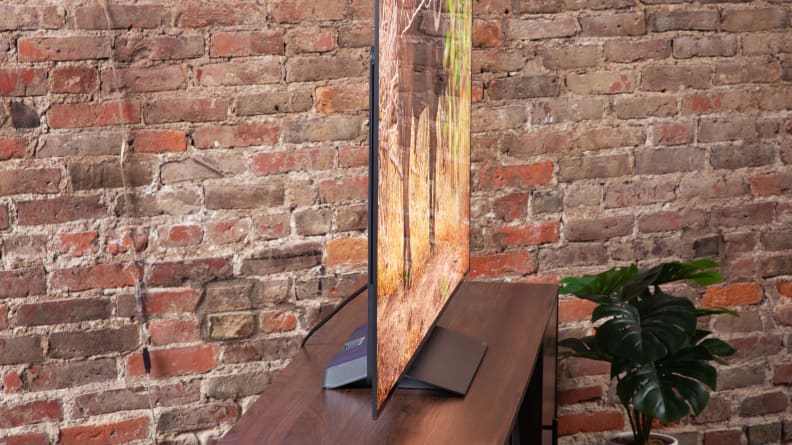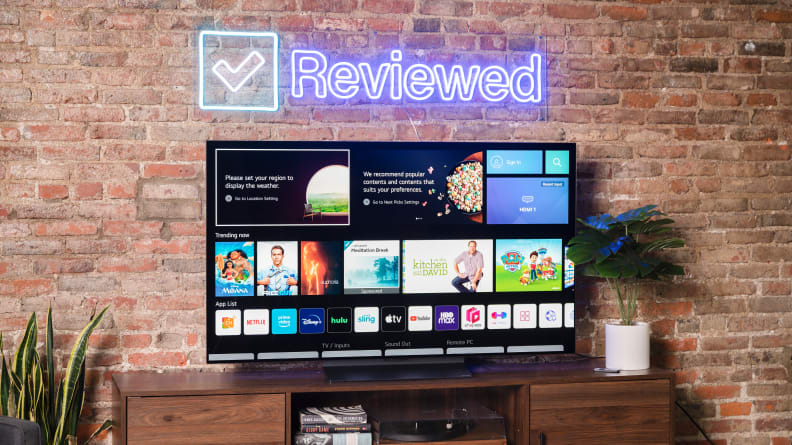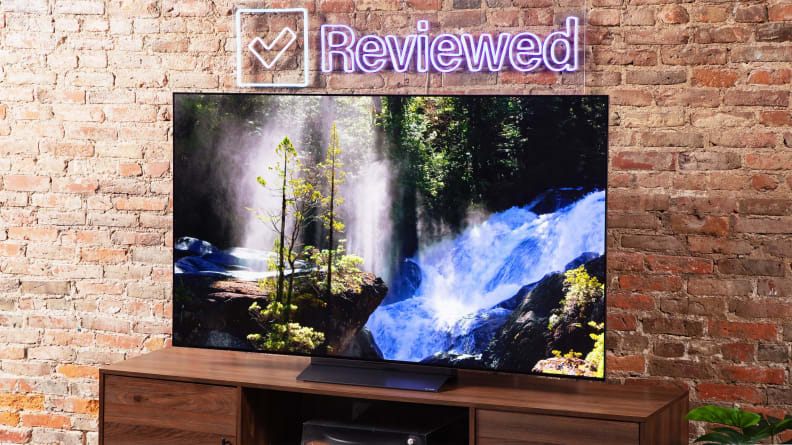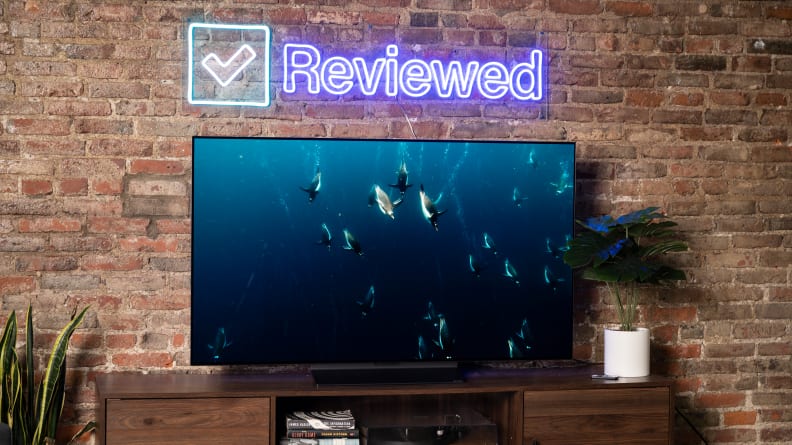It happens every year: As new TVs begin to hit the shelves, last year’s models go on sale. The recently released LG C3 OLED is already a contender for the best TV of the year, but its predecessor, the LG C2, is on sale for tantalizingly low prices.
If you’re already in the market for a top-tier TV like the C3, you’re probably wondering if it’s worth the added cost, or if the discounted C2 is a savvy way to get most of the C3’s benefits for a substantially lower price. Fortunately, we’ve tested each model extensively. Here’s how the C3 and C2 compare, from price to picture quality.
Price

Credit:
Reviewed / Betsey Goldwasser
The C2’s prices have been marked down considerably.
The biggest difference between the C3 and C2 has nothing to do with either TV’s performance, but rather, their current price. Being a brand new TV that hit shelves a few weeks ago, the C3 is not currently discounted. Here’s how the lineup looks:
LG C3:
- 42-inch (LG OLED42C3PUA), MSRP $1,399.99
- 48-inch (LG OLED48C3PUA), MSRP $1,499.99
- 55-inch (LG OLED55C3PUA), MSRP $1,899.99
- 65-inch (LG OLED65C3PUA), MSRP $2,600
- 77-inch (LG OLED77C3PUA), MSRP $3,599.99
- 83-inch (LG OLED83C3PUA), MSRP $5,299.99
The C3 is available in six sizes ranging from 42 to 83 inches. The popular 55-inch model will set you back $1,900, while the smallest size in the series costs $1,400.
As mentioned, the LG C2 has been marked down substantially since its release a year ago. For the sake of context, I’m reporting both the original MSRP of each as well as its sale price at the time that this is being written. There’s no guarantee that these sale prices will remain the same by the time you read this, but going forward, I don’t expect the costs to climb much further.
LG C2:
- 42-inch (LG OLED42C2PUA), MSRP $1,399.99 (on sale for $996.99 at Amazon)
- 48-inch (LG OLED48C2PUA), MSRP $1,499.99 (on sale for $869.33 at Amazon)
- 55-inch (LG OLED55C2PUA), MSRP $1,799.99 (on sale for $1,177.99 at Amazon)
- 65-inch (LG OLED65C2PUA), MSRP $2,499.99 (on sale for $1,588 at Amazon)
- 77-inch (LG OLED77C2PUA), MSRP $3,499.99 (on sale for $2,746.99 at Amazon)
- 83-inch (LG OLED83C2PUA), MSRP $5,499.99 (on sale for $3,936.99 at Amazon)
The C2 is available in exactly the same size options as the C3. Currently, the 55-inch model can be purchased for a little under $1,200, while the 48-inch is on sale for just under $900.
There’s no two ways about it: With identical size options in play, the C2’s discounted price tags puts it over the top. It’s simply a much better option for those looking to spend less.
Our pick: LG C2
Design

Credit:
Reviewed / Timothy Renzi
Both the LG C3, above, and its predecessor have excellent design features.
From a design standpoint, the C3 and C2 are twins. Like most OLED TVs, their panels are remarkably thin—about the width of a smartphone. Both TVs have a bit of bulk around their midsection (where their internals are housed), but at their thickest point, they’re still narrower than most TVs. If you spin them both around, you’ll find their ports arranged similarly alongside the edge of their chassis.
Both TVs are built with a lightweight, composite-fiber material, making setup and repositioning relatively easy. The C3 and C2 share a stand design, too: a downward-angled slab that acts as a pedestal and provides about two inches of clearance for a soundbar. There is a slight wobble to both panels when jostled, but not from heavy nearby footsteps.
Even their remote controls are the same. Both TVs ship with LG’s Magic Remote, which can be used traditionally or as a motion-controlled wand. Simply wiggle the remote to activate the feature, and the on-screen cursor will track your hand movements.
The C3 and C2 are handsomely crafted TVs that are nearly indistinguishable from one another. This category is a tie.
Our pick: Draw
Features and smart platform

Credit:
Reviewed / Betsey Goldwasser
The webOS experience of the C3 is very similar to those of the C2, above.
When it comes to the C Series’ features and enhancements, not much has changed year-over-year. Before we dive into what sets the C3 and C2 apart, let’s take a look at the features they have in common:
- Resolution: 4K (3,840 x 2,160)
- Display type: OLED
- HDR support: Dolby Vision, HDR10, HLG
- Dolby Atmos: Yes (native decoding)
- eARC support: Yes
- Native refresh rate: 120Hz
- HDMI: 4x HDMI 2.1
- Smart platform: webOS
- Color: DCI-P3 color space/10-bit chroma resolution
- Variable Refresh Rate (VRR): Yes
- Auto Low Latency Mode (ALLM): Yes
- Other features: Filmmaker Mode, Game Optimizer, AMD Free Sync Premium Pro, Nvidia G-Sync compatibility, Google Assistant, Amazon Alexa, Apple AirPlay, Apple Home, hands-free voice control
A/V enthusiasts are sure to feel right at home with either of these high-end TVs. Both support Dolby Vision, one of the most popular HDR formats. In addition, both TVs can either decode Dolby Atmos audio natively or pass it via eARC to Dolby Atmos soundbars—either in the uncompressed format (Dolby TrueHD) or the compressed format (Dolby Digital Plus).
One relatively minor difference between these two TVs is DTS audio support. The C3 is the first LG OLED in years to support DTS audio. If you own Blu-rays with DTS soundtracks, you won’t be getting the full DTS experience on the C2 unless you connect your player to an A/V receiver that can handle the decoding.
For gaming, each TV supports both Variable Refresh Rate (VRR) and Auto Low Latency Mode (ALLM) for smoother, low-latency gaming. In addition, all four of the HDMI inputs on both the C2 and C3 support 4K gaming at 120Hz, so you can connect up to three devices to gaming-optimized inputs while still reserving the eARC-enabled input for a soundbar.
Both TVs feature LG’s Game Optimizer menu, a gaming-specific settings menu that can be quickly accessed while using a console or PC. It displays frame rate information, lets you easily tweak the picture based on genre, and toggles the TV’s performance-related gaming features. Both the C2 and the C3 deliver incredibly low input lag, too, making them great for competitive gaming in particular.
Smart features are nearly identical, too. LG’s webOS is accessed from a home screen where users can navigate a wide variety of streaming apps, and there are surplus apps available for download, should you decide to make webOS your primary streaming hub. I found the webOS experience on the C3 to be moderately smoother than it is on last year’s C2, but both iterations of the platform feature recommended and sponsored content.
The C3 also has a slightly updated menu design, which puts frequently used menu options in a quick menu that can be accessed at any time. It’s a minor change, but one that will come in handy for those who tinker with settings often. In addition, there’s a new picture processing-related setting on the C3 called Expression Enhancer, but it’s not a game-changing feature with wide appeal.
In fact, there are very few differences between the hardware- and software-related features found on the C3 and the C2. Unless DTS audio is a major priority, the experience will be close to indistinguishable for most people.
Our pick: Draw
Performance

Credit:
Reviewed / Timothy Renzi
The C3’s picture performance edges out the C2 only by a hair—they’re both superlative.
The C3 and C2 are top-tier TVs making use of high-end hardware, so whichever you choose, you can expect sensational performance across the board.
Both TVs deliver the picture-perfect black levels we’ve come to expect from OLED displays, and they supplement this amazing contrast with rich, accurate color and smooth motion handling. Like all OLED TVs, the C3 and C2 hold up well during off-axis viewing, too. White (and lighter gray tones) tend to shift into a light pink color when viewed off-axis, but the effect is minor and there’s no color shift outside of this phenomenon.
Technically speaking, the C3 offers slightly better performance than the C2, but the differences are subtle. The C3 covers more of the HDR color gamut (DCI-P3), but the difference comes down to 99% versus 97%. The C3 also gets brighter than the C2 by a hair. Side by side, the C3’s added brightness is only noticeable in the form of small, intense highlights, like in the reflection of sunlight off the surface of water.
Most of the difference in brightness can be attributed to the C3’s new chipset and updated picture processing, which elevates perceived brightness by analyzing the image and emphasizing its brighter elements. The C3 also displays near-black picture elements a bit more deftly, limiting the blocky visual artifacts I’ve often seen during dark scenes on the C2.
Our pick: LG C3
And the winner is…

Credit:
Reviewed / Betsey Goldwasser
You can’t really go wrong with either the C2, above, or its successor, so let your priorities and pocketbook guide you.
This one’s too close to call. If you can purchase the LG C2 on sale, I recommend doing so; it’s still one of the best TVs on the market, despite being a year old, and it tends to be greatly discounted due to the release of its successor.
That said, I understand the appeal of buying the latest and greatest, and while the LG C3 is quite similar to its predecessor, it’s got a faster, more powerful chipset, improved picture processing, DTS audio support, and the intangible quality of being a newer model. It’s worthy of its current price, but like the C2, that price is sure to come down significantly in a year’s time. Regardless of which you choose, you’ll be locking down one of the best TVs available today.

LG C2 OLED TV
The LG C2 offers world-class picture quality, top-tier gaming, and a wafer-thin design.

LG C3 OLED TV
The LG C3 features incredible contrast, vivid and accurate color, and gaming features galore.
The product experts at Reviewed have all your shopping needs covered. Follow Reviewed on Facebook, Twitter, Instagram, TikTok, or Flipboard for the latest deals, product reviews, and more.
Prices were accurate at the time this article was published but may change over time.










